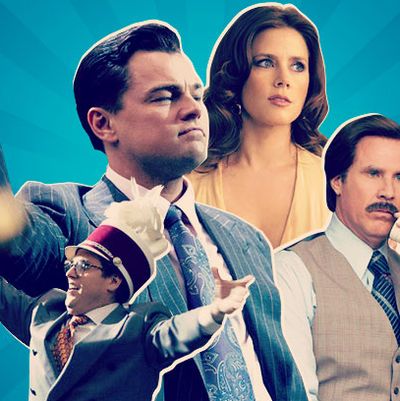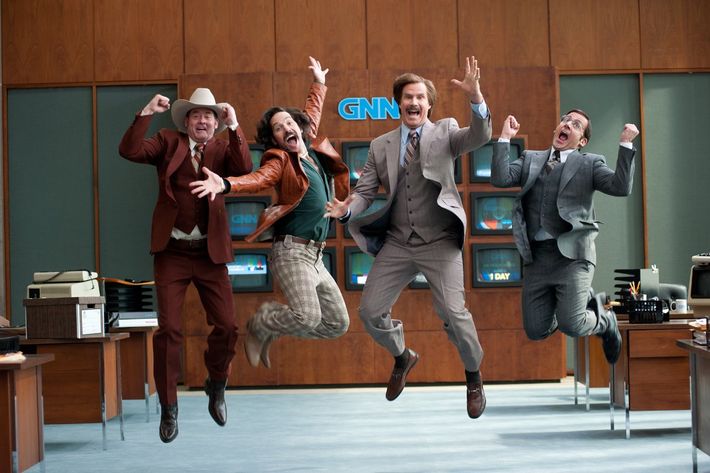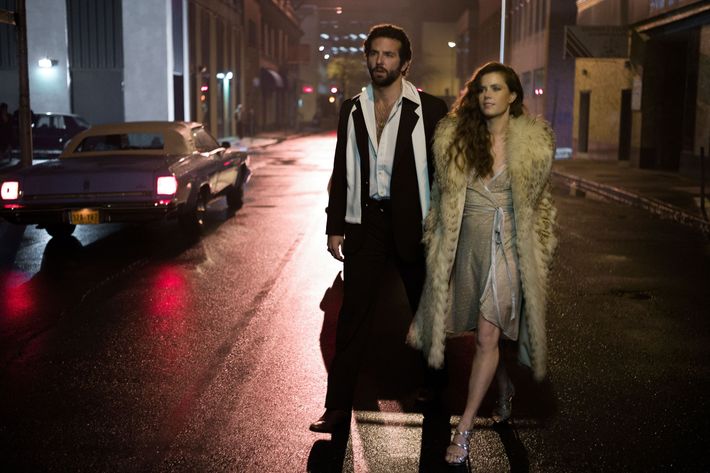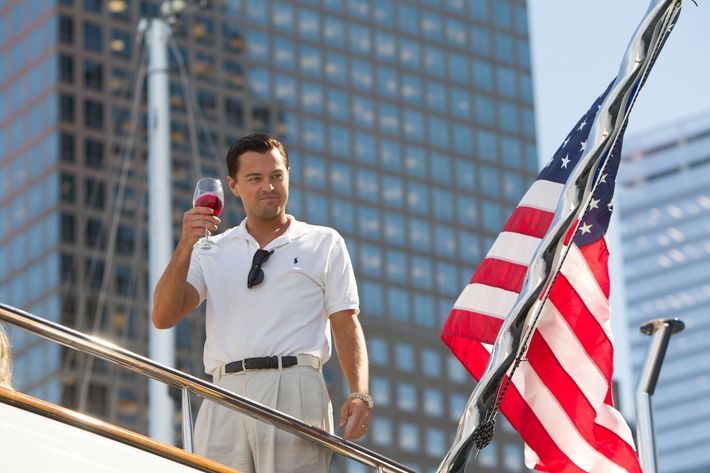
Last month, a trio of movies set in the not-too-distant past hit theaters chock-full of era-appropriate songs. Anchorman 2 had a list of ironically used seventies soft-rock jams and classic-rock staples; American Hustle went back and forth between classy, jazzy instrumentals and intensely seventiesrock and disco hits; and The Wolf of Wall Street was just all over the place, as Martin Scorsese movies usually are. Some of the choices were inspired, some were visceral, some were predictable and tired, and some lyrics were painfully on the nose: But which soundtrack was best?
Anchorman 2: The Legend Continues

Best Uses of Music
- Captain and Tennile’s “Muskrat Love,” which plays as Ron’s RV flips over in slow motion and a bowling ball, scorpion, and deep fryer do heavy damage to the news team.
- Kenny Rogers’s “Lady,” which plays as Brick sees Kristen Wiig’s Chani across the room, eats her lipstick, and then defends her against her boss.
- Earth, Wind & Fire’s “After the Love Has Gone,” which plays as Ron and his African-American boss Linda Jackson do the dirty for the first time, interspersed with clips of other racial-barrier-crossing moments (Kirk on Star Trek, Charlton Heston in Planet of the Apes).
Most Obvious Uses of Music
- Sniff ‘n’ the Tears’s “Driver’s Seat,” which plays when Ron … drives off to find the members of his old news team.
- Seals & Crofts’s “I Really Want to See You Tonight,” which plays when Ron … really wants to see Veronica.
- Foreigner’s “Feels Like the First Time,” which plays when Ron scores megaratings and is a grand success … like the first time, the very first time.
What purpose does music serve on this soundtrack?
Anchorman 2 uses music in three ways: (1) for straight-up humor, as in the scene where “Lady” plays, drops out, and then abruptly picks up again after Brick has a total freak-out; (2) as interstitial music, doing little more than providing an easy, ha-ha-remember-this-cheesy-song transition out of and into scenes; and (3) as blindingly obvious backup material to repeat in song exactly the actions or emotions we are seeing onscreen. The choices feel too familiar and easy, like the soundtrack was assembled by someone who knew little of seventies and early eighties music outside of what they had seen on a Time-Life compilation infomercial.
American Hustle

Best Uses of Music
- Donna Summers’s “I Feel Love,” which plays when Agent DiMaso and Sydney dance together at a strobe-lit disco.
- Elton John’s “Goodbye Yellow Brick Road,” which plays as everyone shows up in Atlantic City for the big con.
- Mayssa Karaa’s cover of Jefferson Airplane’s “White Rabbit,” which plays as the gang and their faux sheik sits down with mobster Victor Tallegio. This Arabic-language cover of a psychedelic song is perfect for the woozy, out-of-control feeling the con artists are experiencing.
Most Obvious Uses of Music
- Santana’s “Evil Ways,” which plays as Roslyn thoughtlessly (but perhaps purposefully) walks over to the casino mobsters and starts chatting them up, showing off her … evil ways.
- Paul McCartney’s “Live and Let Die,” which is sung by Roslyn after she sells her husband Irving out to her new mobster beau and she decides to … live and let die.
What purpose does music serve on this soundtrack?
As a way of ramping up the characters’ emotions — witness the bathroom stall scene between DiMaso and Sydney, the end of which unfolds to the tune of Harold Melvin and the Blue Notes’s “Don’t Leave Me This Way,” foreground the FBI agent’s desire. (And blue balls.) Or Jack Jones’s “I’ve Got Your Number,” which is used to soundtrack Sydney and Irving’s sweet infatuation with each other as they dance giddily across a street and swirl in each other’s arms around a ballroom. As he proved with Silver Linings Playbook and The Fighter, David O. Russell is really good at bodies moving. He should just do a musical already, right? (Or maybe, as critic Glenn Kenny writes, Hustle is simply a series of mini-music videos: “Russell seems to deeply deplore the fact that karaoke had not caught on in America in the late ‘70s, or that he wasn’t able to configure the whole film as a musical, because he does love to let his actors sing, and when he can’t have them sing, he likes to cut to shots of them copping various attitudes while a particular song plays out, in full or something like it, over the soundtrack.”)
The Wolf of Wall Street

Best Uses of Music
- Howling Wolf’s “Smokestack Lightning,” which plays as Stratford Oakmont has its first bacchanal — the sound drops out and Howling Wolf’s (is the double Wolf too on the nose?) “woo-hoo”s drop in as a mess of strippers, strobe lights, and confetti fill the screen.
- Jimmy Castor’s “Hey Leroy, Your Mama’s Callin’ You,” which plays following Jordan’s showstopping Steve Madden IPO speech to get his troops amped. The camera swoops across the ceiling, parting the sea of wild traders who are calling clients like Leroy’s mama in the song.
- Naughty by Nature’s “Hip Hop Hooray,” which plays as Jordan & Co. party on the top of a yacht, throwing cocaine up in the air like they’re trying to seed a lawn. It’s just a wonderful moment.
- Umberto Tozzi’s
cover of“Gloria,” which plays as Jordan’s yacht sinks and his and Donnie’s wives dance with their Italian Navy saviors.
Most Obvious Uses of Music
- Foo Fighters’s “Everlong,” which plays as Jordan and his wife take off on a several week yacht trip and they want the idyll to be … everlong. (“If everything could ever feel this real forever / If everything could ever be this good again)
- Billy Joel’s “Movin’ Out,” which plays as Jordan and Donnie look for a new physical location to launch their business because they’re … movin’ out. (Also, they’re from Long Island.)
What purpose does music serve on this soundtrack?
The movie feels like it’s wall-to-wall music. And to be sure, it has many more songs and cues than either Anchorman 2 or American Hustle. (The fact that it’s three hours has something to do with that.) But at its best, the music is used as a propulsive, rhythmic element, driving the movie forward and linking scenes together — several songs stretch across different scenes, disappearing and then returning minutes later. Bo Diddley’s “Pretty Thing” soundtracks the wild orgy on Jordan’s bachelor party plane, then vanishes, then comes back at the end of his wedding. 7Horse’s “Meth Lab Zoso Sticker” starts in the scene where Brad’s wife is getting money taped across her breasts, continues into the moments when she (and others) funnels money across the Swiss border, and continues into Brad and Donnie’s fight in the parking lot. Plastic Bertrand’s “Ca Plane Pour Moi,” lends the Benihana bust scene (“Beni-FUCKING-HANA”) a punky, yet silly, energy.
So which is best?
Look, Martin Scorsese is a music master, okay? (Remember the beginning of the paranoid Ray Liotta helicopter scene in Goodfellas, soundtracked by Harry Nilsson’s “Jump Into the Fire,” or the “Be My Baby” opening from Mean Streets?) Not only because his movies feature good music — and here, not a Rolling Stones song among the bunch — but also because it’s wide-ranging and complex. The Wolf of Wall Street could have gone for a wall-to-wall eighties and nineties soundtrack, but instead spread its selections over decades (Bo Diddley to Foo Fighters), styles (blues to hip-hop), and even languages. It’s nowhere as obvious as Anchorman 2 and has nearly none of the Zemeckis-lite, on-the-nose choices of American Hustle.

